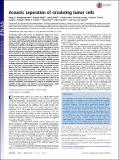Acoustic separation of circulating tumor cells
Author(s)
Li, Peng; Mao, Zhangming; Peng, Zhangli; Zhou, Lanlan; Chen, Yuchao; Huang, Po-Hsun; Truica, Cristina I.; Drabick, Joseph J.; El-Deiry, Wafik S.; Dao, Ming; Suresh, Subra; Huang, Tony Jun; ... Show more Show less
DownloadLi-2015-Acoustic separation.pdf (1.113Mb)
PUBLISHER_POLICY
Publisher Policy
Article is made available in accordance with the publisher's policy and may be subject to US copyright law. Please refer to the publisher's site for terms of use.
Terms of use
Metadata
Show full item recordAbstract
Circulating tumor cells (CTCs) are important targets for cancer biology studies. To further elucidate the role of CTCs in cancer metastasis and prognosis, effective methods for isolating extremely rare tumor cells from peripheral blood must be developed. Acoustic-based methods, which are known to preserve the integrity, functionality, and viability of biological cells using label-free and contact-free sorting, have thus far not been successfully developed to isolate rare CTCs using clinical samples from cancer patients owing to technical constraints, insufficient throughput, and lack of long-term device stability. In this work, we demonstrate the development of an acoustic-based microfluidic device that is capable of high-throughput separation of CTCs from peripheral blood samples obtained from cancer patients. Our method uses tilted-angle standing surface acoustic waves. Parametric numerical simulations were performed to design optimum device geometry, tilt angle, and cell throughput that is more than 20 times higher than previously possible for such devices. We first validated the capability of this device by successfully separating low concentrations (~100 cells/mL) of a variety of cancer cells from cell culture lines from WBCs with a recovery rate better than 83%. We then demonstrated the isolation of CTCs in blood samples obtained from patients with breast cancer. Our acoustic-based separation method thus offers the potential to serve as an invaluable supplemental tool in cancer research, diagnostics, drug efficacy assessment, and therapeutics owing to its excellent biocompatibility, simple design, and label-free automated operation while offering the capability to isolate rare CTCs in a viable state.
Date issued
2015-04Department
Massachusetts Institute of Technology. Department of Materials Science and EngineeringJournal
Proceedings of the National Academy of Sciences
Publisher
National Academy of Sciences (U.S.)
Citation
Li, Peng, Zhangming Mao, Zhangli Peng, Lanlan Zhou, Yuchao Chen, Po-Hsun Huang, Cristina I. Truica, et al. “Acoustic Separation of Circulating Tumor Cells.” Proc Natl Acad Sci USA 112, no. 16 (April 6, 2015): 4970–4975.
Version: Final published version
ISSN
0027-8424
1091-6490